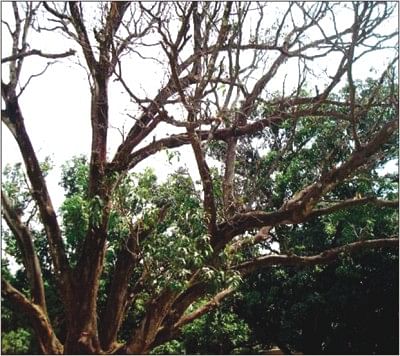Signs of gummosis worry mango growers

Affected with gummosis disease, a mango tree at Court Bagan in Chapainawabganj town is now in a dying state.Photo: STAR
Hundreds of mango trees in the district are being affected with gummosis disease, locally known as athajhora rog, much to the worry of mango growers.
Symptom of the disease is that the affected tree starts secretion of gum at a particular point, it spreads throughout the body within three to six months and then the tree dies.
It is a fungal disease caused by lasiodiplodia-theobromea, scientists of Regional Horticulture Research Station, Chapainawabganj, said after observing the disease at different places in the district.
The disease was first detected two years ago in several mango trees of Kansat Razar Bagan, one of the largest mango orchards in the district.
The scientists came to know that the disease first spread in the mango orchard from nearby shishu trees that had been infected with the disease. Several shishu trees also died of this disease.
The disease, which normally spreads from November to March, has also affected some other orchards in the district, sources said, adding that 100 to 150 years old trees are also dying of this disease.
Several mango farmers complained that they are not getting any cooperation from the Regional Horti-culture Research Station in this regard.
The scientists of the station, however, claimed that they always give advice to the farmers when they come to the station.
If the disease could be detected at initial stages, the trees could be saved using Bordeaux paste, said Sharif Uddin, a scientific officer of the station, adding, “We have saved some of the infected mango trees of the premises of Chapainawabganj Government College and Shah Neyamot Ullah College in the town.
“We are trying to find out the other associate pathogens to come to the final conclusion,” said Mosharraf Hossain, scientific officer the Plant Pathology Department of the station.

 For all latest news, follow The Daily Star's Google News channel.
For all latest news, follow The Daily Star's Google News channel. 



Comments